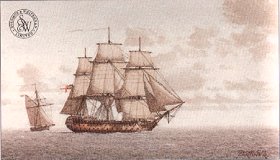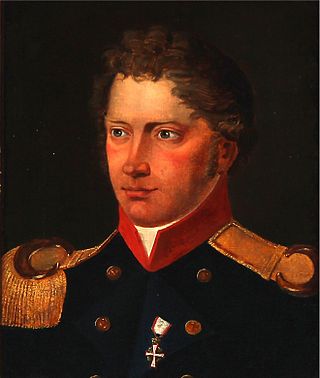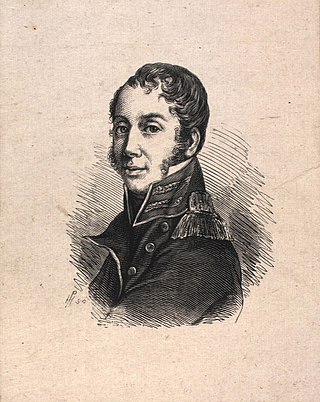
The Gunboat War was a naval conflict between Denmark–Norway and Great Britain supported by Sweden during the Napoleonic Wars. The war's name is derived from the Danish tactic of employing small gunboats against the materially superior Royal Navy. In Scandinavia it is seen as the later stage of the English Wars, whose commencement is accounted as the First Battle of Copenhagen in 1801.

HDMS Najaden was a frigate in the Royal Danish-Norwegian Navy. She was commissioned in 1811 and originally carried 36 guns, later being upgraded to 42. She served briefly during the Gunboat War only seeing action once, when on 6 July 1812 the British ship of the line HMS Dictator and the Cruizer-class brig-sloop HMS Calypso sank her during the Battle of Lyngør. The Battle of Lyngør effectively ended Denmark's involvement in the Napoleonic Wars.

The Battle of Lyngør was a naval action fought between Denmark-Norway and the United Kingdom in 1812 on the southern coast of Norway. The battle ended in a Dano-Norwegian defeat, and marked the end of the Kingdom of Denmark-Norway's involvement in the Napoleonic Wars.

HDMS Najaden was a frigate of the Royal Dano-Norwegian Navy, which she served from 1796 until the British captured her in 1807. While in Dano-Norwegian service she participated in an action at Tripoli, North Africa. She served the Royal Navy as the fifth rate HMS Nyaden from 1808 until 1812 when she was broken up. During her brief British service she participated in some small attacks in the Barents Sea during the Anglo-Russian War.
HMS Fox was a 32-gun Active-class fifth rate frigate of the Royal Navy. She was launched on 2 June 1780 at Bursledon, Hampshire by George Parsons.

HMS Clio was a Cruizer-class brig-sloop of the Royal Navy, launched at James Betts' shipyard in Mistleythorn in Essex on 10 January 1807. Her establishment was 71 officers and men, 24 boys and 20 marines. She served in the Baltic during the Napoleonic Wars, accomplished the re-establishment of British rule on the Falkland Islands in 1833, and participated in the First Opium War. She was broken up in 1845.

HMS Apollo, the fifth ship of the Royal Navy to be named for the Greek god Apollo, was a fifth-rate frigate of the Lively class, carrying 38 guns, launched in 1805 and broken up in 1856.

HMS Hydra launched in 1797 was a fifth-rate frigate of the Royal Navy. From 1813 to 1817 she served as a troopship. She was sold in 1820.

HMS Edgar was a 74-gun third-rate ship of the line of the Royal Navy, that saw service in the American Revolutionary, French Revolutionary and Napoleonic Wars. Launched in 1779, she fought in the battles of Cape St Vincent and Copenhagen, two of the major naval engagements of the wars.
HDMS Brev Drageren was a Danish let brigger, launched in 1801 for the Royal Danish Navy. She was one of the many vessels the British captured from the Danish after the Battle of Copenhagen in 1807. She was subsequently added to the Royal Navy as HMS Brev Drageren, and was involved in two notable actions while in British service. She was sold in 1825.

HMS Calypso was a Royal Navy Cruizer-class brig-sloop. She was built at Deptford Wharf between 1804 and 1805, and launched in 1805. She served in the North Sea and the Baltic, most notably at the Battle of Lyngør, which effectively ended the Gunboat War. Calypso was broken up in March 1821.

HMS Belette was an 18-gun Cruizer-class brig-sloop, built by King at Dover and launched on 21 March 1806. During the Napoleonic Wars she served with some success in the Baltic and the Caribbean. Belette was lost in the Kattegat in 1812 when she hit a rock off Læsø.
HMS Nemesis was a 28-gun Enterprise-class sixth-rate frigate of the Royal Navy. The French captured her in 1795 at Smyrna, but in 1796 a squadron led by Barfleur brought her out of the neutral port of Tunis. Throughout her career she served under a number of commanders who would go on to have distinguished careers. She was converted to a troopship in 1812 and was sold in 1814.

The Battle of Saltholm was fought on 9 June 1808 during the Gunboat War. Danish and Norwegian ships attacked a British convoy off the island of Saltholm in Øresund Strait near Copenhagen.

Grinder was a gunboat serving as a tender, rather than a commissioned warship, to HMS Anholt, the British garrison on the island of Anholt during the Gunboat War. Grinder's origins are obscure, but the Danes captured her in 1810 and the British recaptured her in 1811. She was sold in 1832.

Peter Nicolay Skibsted (1787–1832) was a Danish naval officer with a successful career marred only by the loss in 1810 of a squadron of three gunboats under his command to the British.

Hans Peter Holm was a Danish naval officer who commanded vessels of the Dano-Norwegian Navy in several actions. He commanded several naval vessels during the Gunboat War. His most important action occurred in 1812 at the Battle of Lyngør when a British squadron, led by the British ship-of-the-line HMS Dictator, destroyed his vessel, HDMS Najaden. Holm sustained wounds in the battle but survived, only to drown in an accident shortly afterwards.
HDMS Lolland was launched in March 1810. She served in at least four major engagements during the Gunboat War before she was transferred to the Norwegian navy after the Treaty of Kiel brought about the separation of Norway from Denmark in 1814. Lolland continued to serve with the Norwegian Navy until sold in 1847.

HDMS Allart, a brig launched at Copenhagen in June 1807, was amongst the ships taken by the British after the second Battle of Copenhagen. In British service, she was recaptured by Danish-Norwegian gunboats after venturing too close inshore. Her subsequent service was in the Dano-Norwegian Navy's Norwegian Brig Division, which harried enemy frigates and convoys in Norwegian waters. In 1812, she was captained by Ulrich Anton Schønheyder. His father was after the mother's death married to Joachime Catharine Benzon (1757-1836). On the separation of Denmark from Norway in 1814, Allart transferred to the Norwegian navy, who sold her in 1825.

HMS Podargus was a Crocus-class brig-sloop of the Royal Navy. She participated in one major battle during the Gunboat War between Britain and Denmark. After the war she served at Saint Helena for five or six years. On her return to Britain in 1820 she was laid up; she was finally sold in 1833.

















